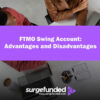Understanding OspreyFx prop firm payout structure and the related hazards will enable traders to make well-informed choices that complement their financial objectives. A proprietary trading firm called OspreyFX has been popular among traders looking to leverage large sums of money without jeopardizing their own money. OspreyFX, which was founded in 2019 and is registered in St. Vincent and the Grenadines, stands out from other prop firms thanks to its distinctive payout structure. The details of OspreyFx prop firm payout structure, such as its profit-sharing model, withdrawal procedures, and overall advantages for traders, will all be covered in detail in this article.
Osprey Prop Firm Payout Structure
Model of Profit Sharing
OspreyFX’s profit-sharing model, which lets traders keep a sizable amount of their gains, is the main factor that makes it so appealing. Depending on the trader’s circumstances and the type of account, the firm offers a competitive profit-sharing ratio of up to 90%. The goal of this strategy is to connect the interests of the trader with the firm while providing incentives for performance.
- Profit Retention: After finishing the first challenge phases, traders usually keep 70% of their profits; however, depending on certain agreements or higher-tier accounts, this percentage may rise to 90%. This makes it financially attractive for skilled traders because they can keep a sizable share of every dollar gained.
- Performance Bonuses: For traders who surpass specific benchmarks, OspreyFX may provide performance bonuses or incentives in addition to standard profit sharing. This incentivizes traders to optimize their trading tactics and attain greater profits.
Payout Frequency
- Traders can select between bi-weekly and weekly rewards with OspreyFx prop firm payout structure flexible feature. When traders accept the challenge, they can choose to receive weekly rewards for an extra cost, but standard payouts happen every two weeks. For traders who would rather have more regular access to their gains, this flexibility can be helpful since it allows them to quickly fund personal costs or reinvest profits.
Procedure for Withdrawal
OspreyFX’s withdrawal procedure is simple, but there are some rules to follow:
- Fees for Withdrawals: Withdrawals up to $5,000 from a bank are subject to a $25 charge. This charge schedule, which helps defray the administrative expenses related to processing withdrawals, is comparatively typical in the sector.
- Timing: Every Monday at 12:00 server time, withdrawals are handled. To guarantee prompt access to their money, traders should carefully consider their withdrawal requests.
- Minimum Amounts Withdrawn: Although explicit minimum withdrawal amounts are not specified, traders should aim to build up enough profits before making a withdrawal so that, after deducting costs, it is beneficial.
Types of Accounts and Funding Levels
A variety of account types with different financing levels and related fees are available from OspreyFX. Every kind of account has unique needs and possible profit-sharing plans:
Account Type: Basic
- Funding Amount: $25,000
- Refundable Fee: $220
- Profit Sharing: 70%
Account Type: Starter
- Funding Amount: $50,000
- Refundable Fee: $359
- Profit Sharing: 70%
The Account Type: Pro
- Funding Amount: $100,000
- Refundable Fee: $599
- Profit Sharing: 70%
Account Type: Advance
- Funding Amount: $200,000
- Refundable Fee: $999
- Profit Sharing: 70%
To take part in the challenge linked to each account type, traders need to pay a refundable registration fee. These payments are reimbursed after the challenge phases are successfully finished, enabling traders to access funded accounts without incurring large upfront expenses.
Phases of Challenge
The OspreyFX Prop Challenge is a three-step assessment that traders must finish in order to be eligible for a funded account. Every stage has distinct goals and guidelines for risk management:
- Phase 1: Traders must reach a 10% profit target within a predetermined time frame (usually 10–30 days) after starting with a minimum balance (e.g., $25,000. The overall loss cap is set at 12%, and the maximum daily loss is capped at 5%.
- Phase 2: After traders successfully complete Phase 1, they go on to Phase 2, where they may have more time (up to 60 days) to reach an 8% profit target while staying inside the same loss restrictions.
- Funded Phase: Following successful completion of both stages, traders are granted access to their funded accounts, where they can keep gains based on the predetermined share ratio while continuing to trade under comparable risk management guidelines.
Risk Management Guidelines
Strict risk management guidelines are used by OwlFX in all stages of trading:
- Daily Loss Limits: In order to prevent excessive losses under erratic market conditions, traders are subject to a daily loss restriction of 5%.
- Total Loss Limits: To ensure that the trader and the firm both successfully manage risk, the maximum total loss permitted is set at 12%.
These safeguards are in place to promote responsible trading among users as well as to safeguard OspreyFX’s capital.
Advantages of Using OspreyFX for Trading
Selecting OspreyFX as a prop trading partner has the following benefits:
- High Leverage Options: OspreyFX offers traders leverage ratios up to 500:1, which enables them to control larger positions than their initial capital would allow. This can greatly increase potential profits.
- Diverse Asset Classes: OspreyFX allows traders to trade a variety of asset classes, such as stocks, commodities, forex, and cryptocurrencies, allowing them to implement different strategies based on market conditions.
- Educational Resources: As part of its dedication to trader development, OspreyFX offers educational resources and support to improve trading skills and strategies, including webinars, tutorials, and market analysis tools.
- Community Support: Interacting with a group of traders who share similar interests can yield insightful conversations and networking opportunities that improve overall trading performance.
Conclusion
Because of its encouraging trading environment and alluring payment structure, OspreyFX stands out in the proprietary trading market. For traders who want to maximize their potential without risking their own money, it presents an alluring possibility with customizable payout options, strict risk control procedures, and attractive profit-sharing ratios of up to 90%.
Before making a commitment, potential traders should carefully read all terms and conditions, just like with any financial venture. Gaining knowledge of OspreyFx prop firm payout structure and related risks will enable traders to make well-informed choices that support their financial objectives. OspreyFX offers a strong platform with tools built for success in today’s dynamic markets, regardless of your prior trading expertise or level of inexperience with proprietary trading.
Frequently Asked Questions
What Is The Profit-Sharing Ratio At OspreyFX?
- OspreyFX provides traders with a competitive profit-sharing plan that allows them to keep up to 90% of their earnings. A typical profit split for funded accounts following the evaluation stages is 70%, though the precise number may change based on the trader’s performance and the type of account chosen.
How Often Are Payouts Made?
- Weekly payments are available to traders; these are normally processed every Monday at 12:00 server time. Traders can choose to switch to weekly rewards during the challenge setting for an extra cost if they would prefer more frequent payouts.
Is There A Minimum Trading Day Requirement?
- Indeed, traders must finish at least 10 trading days in both Phase 1 and Phase 2 of OspreyFX’s evaluation process. Before being granted access to funded accounts, traders must exhibit steady performance over an extended period of time, according to this criteria.
Are There Any Fees Associated With Withdrawals?
- Yes, withdrawal fees are charged by OspreyFX. The standard cost for bank withdrawals up to $5,000 is $25. To make sure they optimize their net profits, traders should take this cost into account when scheduling their withdrawals.


















